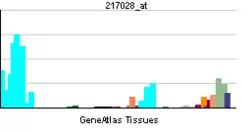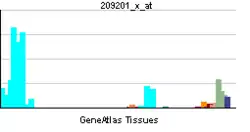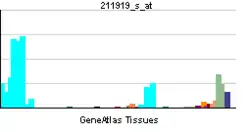CXCR4
趋化因子受体CXCR4是趋化因子基质细胞衍生因子-1(CXCL12)的特异受体[1][2]。CXCL12对淋巴细胞有强烈的趋化作用。该受体是用来提取纯化艾滋病毒的几个趋化因子受体之一。现在还不清楚是否出现使用CXCR4的人类免疫缺乏病毒是免疫缺乏的原因还是后果。
另外,CXCR4还可能人类胚胎发育中的着床过程中起作用。
作为趋化因子受体与配体,CXCR4和CXCL12比较特殊,他们是一配一的受体配体关系。绝大数趋化因子受体有多个配体,一个趋化因子可以结合到两个或多个受体。
CXCR4的配体CXCL12在造血干细胞移居骨髓在起重要作用[3]。影响或阻断CXCR4受体配体结合,可以调节造血干细胞的迁徙,这对骨髓造血干细胞移植可能十分有用。目前的试验药物有:粒细胞集落刺激因子(Granulocyte colony-stimulating factor)和Plerixafor(AMD3100)。但这些药物尚未临床使用。
CXCR4在体内大部分组织和器官上都有表达,它是由352个氨基酸组成的GPCR(G蛋白偶联受体),具有七次穿膜结构。 CXCR4参与体内多种生理机制,包括参与HIV-1病毒侵染【1】,造血功能【2】,胚胎发育【3-7】,及肿瘤迁移等【8】。
参考文献
- Deng H, et al., Identification of a major co-receptor for primary isolates of HIV-1. Nature. 1996 Jun 20;381(6584):661-6.
- Oberlin E, et al., The CXC chemokine SDF-1 is the ligand for LESTR/fusin and prevents infection by T-cell-line-adapted HIV-1. Nature. 1996 Aug 29;382(6594):833
- Zou YR, Kottmann AH, Kuroda M, Taniuchi I, Littman DR. Function of the chemokine receptor CXCR4 in haematopoiesis and in cerebellar development. Nature. 1998 Jun 11;393(6685):595-9.
- Dragic, T., An overview of the determinants of CCR5 and CXCR4 co-receptor function. J Gen Virol, 2001. 82(Pt 8): p. 1807-14.
- Maekawa, T. and T. Ishii, Chemokine/receptor dynamics in the regulation of hematopoiesis. Intern Med, 2000. 39(2): p. 90-100.
- Nagasawa, T., et al., Defects of B-cell lymphopoiesis and bone-marrow myelopoiesis in mice lacking the CXC chemokine PBSF/SDF-1. Nature, 1996. 382(6592): p. 635-8.
- Tachibana, K., et al., The chemokine receptor CXCR4 is essential for vascularization of the gastrointestinal tract. Nature, 1998. 393(6685): p. 591-4.
- Zou, Y.R., et al., Function of the chemokine receptor CXCR4 in haematopoiesis and in cerebellar development. Nature, 1998. 393(6685): p. 595-9.
- McGrath, K.E., et al., Embryonic expression and function of the chemokine SDF-1 and its receptor, CXCR4. Dev Biol, 1999. 213(2): p. 442-56.
- Lu, M., E.A. Grove, and R.J. Miller, Abnormal development of the hippocampal dentate gyrus in mice lacking the CXCR4 chemokine receptor. Proc Natl Acad Sci U S A, 2002. 99(10): p. 7090-5.
- Burger, J.A. and T.J. Kipps, CXCR4: a key receptor in the crosstalk between tumor cells and their microenvironment. Blood, 2006. 107(5): p. 1761-7.
This article is issued from Wikipedia. The text is licensed under Creative Commons - Attribution - Sharealike. Additional terms may apply for the media files.
.png.webp)



